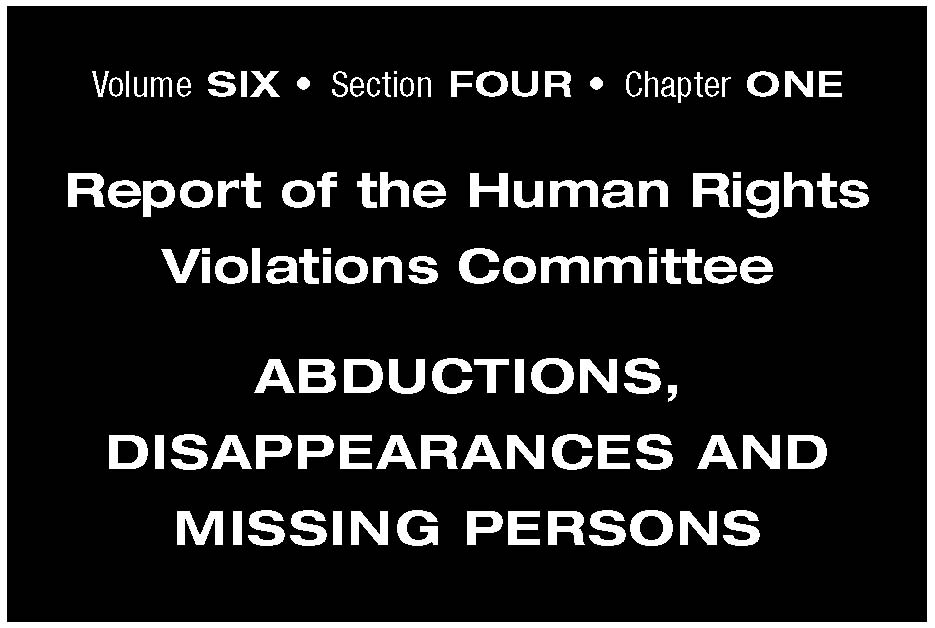 |
News | Sport | TV | Radio | Education | TV Licenses | Contact Us |
 |
News | Sport | TV | Radio | Education | TV Licenses | Contact Us |
TRC Final ReportPage Number (Original) 512 Paragraph Numbers 1 to 10 Volume 6 Section 4 Chapter 1 Subsection 1  Abductions, Disappearances and Missing Persons■ INTRODUCTION1. On 14 October 1986, activist Moss Morudu [JB00520/02PS] went missing from his home in Mamelodi in Pretoria. Shortly thereafter, his family received a telephone call from an unknown person who said that Mr Morudu was where ‘he had always wanted to go’. They deduced from the call that Moss had gone into exile, as he had previously discussed leaving South Africa because of ongoing Security Branch harassment. However, Moss Morudu did not return home with other returning exiles after 1990. 2. A few years later, the Morudu family received a visit from members of the Attorney-General’s office, who indicated that they believed that Moss might have been the victim of a Northern Transvaal Security Branch hit squad. In 1996, the family became aware of rumours that the Truth and Reconciliation Commission (the Commission) was in possession of an amnesty application relating to Moss Morudu. Moss’s mother, Mrs Morudu, began attending every public hearing of the Commission in the Gauteng area in the hope that she would learn of the fate of her son. 3. This is usually the first phase of a disappearance. The family is ignorant about what has happened and is unclear about what the future will bring. Thus begins the long journey of not knowing whether a loved one is imprisoned or dead. 4. Moss’s family was informed about the amnesty application. Finally, in October 1999, the amnesty hearing of three Northern Transvaal Security Branch operatives began in Pretoria. The Morudu family heard that the head of the Northern Transvaal’s Investigative Unit, Captain Hendrik Prinsloo, had instructed two black Security Branch operatives to abduct Moss Morudu. The two had gone to the home of the Mamelodi activist and, purporting to be MK operatives, had persuaded him to accompany them. They then handed him over to their white colleagues at a pre-arranged spot. 5. According to their version, Moss Morudu was not formally detained, but was taken to a temporary interrogation camp near Hammanskraal where he was held and interrogated for approximately one week. The applicants testified that they did not know when he was removed, or where to. They became aware much later that he was no longer there and assumed that he had been killed, as had other abductees. Neither their commander, Captain Prinsloo, nor other implicated white colleagues applied for amnesty, and all denied the version put forward by the black applicants. 6. Thus, although the amnesty hearing provided the family with new information, the Amnesty Committee was, in the end, unable to establish the exact fate of Moss Morudu. And so the quest of the Morudu family continues. 7. Many other families share the experience of the Morudu family. For them too, continued uncertainty about the fate of loved ones has had devastating consequences. These families remain trapped in the past, unable to move on. Unlike a death, which, however painful, leads eventually to some kind of acceptance, families of the disappeared remain constantly caught between near certainty that the missing person has not survived and hope that he or she will return. In several cases the missing person was the breadwinner, making the burden on the family both financial and emotional. 8. A tiny percentage of families have approached the courts to have the missing person declared dead. This has allowed them to claim unpaid wages or, in some instances, the proceeds of policies held in the missing person’s name. In most instances, little or no money is coming in. Expenses increase as families search to find out what happened. 9. The uncertainty of the search and the faint hope that the disappeared will return makes it incredibly difficult for those left behind to cope. The family’s life has changed on several fronts, including the political, social and economic. In addition, many face the psychological consequences of dealing with a disappearance without access to psycho-social support or counselling services. 10. During the conflict period, many families bore the pain of the disappearance alone, tormented by uncertainty, fearful of what would happen to them. They feared the consequences of drawing attention to the missing person or to the family. For example, where missing persons had links to anti-government organisations or were students during periods of unrest, families were too afraid to report the disappearance to the police in case they compromised the missing person’s safety. In any case, as a number of statements confirm, those who did re port disappearances were often met with hostility. Threats, jeers (such as ‘Go ask Mandela where your son is’) and sometimes assaults were often the only responses they received from the authorities. Similarly, in areas such as Natal and certain parts of the Transvaal, enquiries could place the entire family in jeopardy from a rival political movement. In such cases, the only option was tose arch alone: discreetly asking friends, scouring hospitals and mortuaries, desperately trying to find some trace of the missing person. |